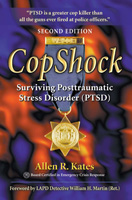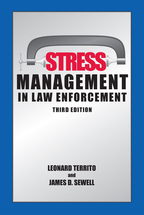
CopShock: Second Edition
Surviving Posttraumatic Stress Disorder (PTSD)
by Allen R. Kates, MFAW, BCECR
Stress Management in Law Enforcement
Third Edition

Table of Contents
Preface xiii
Acknowledgments xvii
About the Editors xix
Part One— What Is Stress All About? 3
1. Laurence Miller (2012) “Stress, Traumatic Stress, and
Posttraumatic Stress Syndromes.” (This article, originally
written for the Second Edition of Stress Management in Law
Enforcement, has been updated for this Edition.) 7
2. Kathleen M. Palm, Melissa A. Polusny, and Victoria M. Follette
(2004) “Vicarious Traumatization: Potential Hazards and
Interventions for Disaster and Trauma Workers,” Prehospital
and Disaster Medicine, 19(1), 73–78 37
3. Mary Carmichael (2009) “Who Says Stress Is Bad for You?”
Newsweek, 153(8) (February 23), 47–50 53
4. Anthony L. Komaroff (2009) “The Usual Suspect,” Newsweek,
153, (8) (February 23), 52, 55 61
Part Two— What Does Stress Mean for Cops? 65
5. Michael L. Arter (2012) “Applying General Strain Theory to
Policing: Examining Police Stress.” (This article was written
specifically for this book.) 69
6. Donald C. Sheehan and Vincent B. Van Hasselt (2003) “Identifying
Law Enforcement Stressors Early,” FBI Law Enforcement Bulletin,
72(9), 1–7 103
7. Dennis Lindsey and Sean Kelly (2004) “Issues in Small Town
Policing: Understanding Stress,” FBI Law Enforcement Bulletin,
73(7), 1–7 113
8. Gary L. Patton (2011) “Coping with the Career: A Review of
Acquired Life Patterns of Veteran Officers,” FBI Law
Enforcement Bulletin, 80(6), 16–23 123
Part Three— Are There Ways We Can Tell It Is There? 133
9. Rebecca M. Pasillas, Victoria M. Follette, and Suzanne E. Perumean-
Chaney (2006) “Occupational Stress and Psychological Functioning
in Law Enforcement Officers,” Journal of Police and Criminal
Psychology, 21(1), 41–53 137
10. Homer C. Hawkins (2001) “Police Officer Burnout: A Partial
Replication of Maslach’s Burnout Inventory,” Police Quarterly,
4(3), 343–360 153
11. Irene Barath (2009) “Stress Management Research at the
Ontario Police College,” The Police Chief, 76(8), 112–121 171
Part Four— What Are Some of the Bad Effects of Stress on Cops? 181
12. Jim Adams and James Walsh (2006) “Cops under Pressure: Driven
to Drink,” Star Tribune, Minneapolis/St. Paul, MN, 6/18/06 185
13. Patricia L. Obst, Jeremy D. Davey, and Mary C. Sheehan (2001)
“Does Joining the Police Service Drive You to Drink? A
Longitudinal Study of the Drinking Habits of Police Recruits.”
Drug Education, Prevention, and Policy, 8(4), 347–357 191
14. Chad L. Cross and Larry Ashley (2004) “Police Trauma and
Addiction: Coping with the Dangers of the Job,” FBI Law
Enforcement Bulletin, 73(10), 24–32 205
15. Kim R. Humphrey, Kathleen P. Decker, Linn Goldberg,
Harrison G. Pope Jr., Joseph Gutman, and Gary Green (2008)
“Anabolic Steroid Use and Abuse by Police Officers: Policy and
Prevention,” The Police Chief, 75 (6), 66–74 217
16. Allen R. Kates (2012) “Sex Addiction in Police Officers as a
Result of Stress and Trauma.” (This article was written
specifically for this book.) 231
17. Melanie Hamilton (2003) “Special Report on Police Suicide: Cop
Killer,” Police, 27(5), 18–21 251
18. New Jersey Police Suicide Task Force Report (2009) 265
Part Five— How Does Stress Impact the Cop’s Family Life? 281
19. Gerard J. Solan and Jean M. Casey (2003) Police Work Addiction:
A Cautionary Tale. FBI Law Enforcement Bulletin, 72(6), 13–17 285
20. Sam Torres, David L. Maggard Jr., and Christine Torres (2003)
“Preparing Families for the Hazards of Police Work,”
The Police Chief, 70(10), 108–114 293
21. John M. Violanti (2007) “Homicide-Suicide in Police Families:
Aggression Full Circle,” International Journal of Emergency
Mental Health, 9(2) 97–104 297
22. Karen Oehme, Elizabeth A. Donnelly, and Zachary Summerlin
(2012) “Agency Innovation to Promote Change: A Model Policy
on Officer-Involved Domestic Violence Provides a Starting Point
to Foster Healthy Police Families.” (This article was written
specifically for this book.) 311
Part Six— How Does the Worst of the Worst Affect Cops? 337
23. Lynn A. Tovar (2011) “Vicarious Traumatization and Spirituality
in Law Enforcement,” FBI Law Enforcement Bulletin, 80(7), 16–21 341
24. Meredith Krause (2009) “In Harm’s Way: Duty of Care for Child
Exploitation and Pornography Investigators,” FBI Law Enforcement
Bulletin, 78(1), 20–29 349
25. Ellen K, Marshall (2006) “Cumulative Career Traumatic Stress
(CCTS): A Pilot Study of Traumatic Stress in Law Enforcement,”
Journal of Police and Criminal Psychology, 21(1), 62–71 363
26. Thomas R. McDearis (2009) “Wounded Warriors and the
Virginia Tech Tragedy: A Police Chaplain’s View,” FBI Law
Enforcement Bulletin, 78(1), 13–19 375
Part Seven— What is the Impact of Foreign Wars on Our Cops? 383
27. Leonard Territo (2008) “Military Combat Veterans: What They Mean
for Your Department,” Florida Police Chief, 34(4), 26–31 387
28. John M. Violanti (2012) “Double Dose-Trauma: Suicide Risk
among Deployed Police Officers.” (This article was written
specifically for this book.) 399
29. Barbara Webster (2008) Combat Deployment and the
Returning Police Officer. Washington, DC: U.S. Department
of Justice Office of Community Oriented Policing Services 419
30. Laurence Miller (2012) “Military and Law Enforcement
Psychology: Cross-Contributions to Extreme Stress
Management.” (This article was written specifically for this book.) 447
Part Eight— What Are the Tools That a Cop Can Use to Better Handle Stress? 479
31. Joseph A, Harpold and Samuel L. Feemster (2002) “Negative
Influences of Police Stress,” FBI Law Enforcement Bulletin,
71(9), 1–7 483
32. Douglas Paton, Peter Johnston, Joanna Clarke, John M.
Violanti, Karena J. Burke, and Denise Keenan (2008) “Stress
Shield: A Model of Police Resiliency,” International Journal
of Emergency Mental Health, 10(2), 95–107 493
33. Laurence Miller (2008) “Stress and Resilience in Law
Enforcement: Training and Practice,” International Journal
of Emergency Mental Health, 10(2), 109–124 515
34. Richard F. Cipriano (2011) “Stress Management Techniques:
A Practical Approach.” (This article was written specifically
for this book.) 543
Part Nine— What Support Is Available for Cops? 551
35. Laurence Miller (2000) “Law Enforcement Traumatic Stress:
Clinical Syndromes and Intervention Strategies,” Trauma
Response, 6(1), 15–20 555
36. Carol Logan (2012) “PTSD Treatment for Law Enforcement
Personnel: An Information Processing Perspective.”
(This article was written specifically for this book.) 573
37. Mark D. Kamena, Douglas Gentz, Virginia Hays, Nancy
Bohl-Penrod, and Lorraine W. Greene (2011) “Peer Support
Teams Fill an Emotional Void in Law Enforcement Agencies,”
The Police Chief, 78(8), 80–84 591
38. Frank G. Dowling, Bill Genet, and Gene Moynihan (2005) “A
Confidential Peer-Based Assistance Program for Police Officers,”
Psychiatric Services, 57(7), 870–71 601
39. Richard L. Levenson, Andrew F. O’Hara, and Ron Clark
(2010) “The Badge of Life Psychological Survival for Police
Officers Program,” International Journal of Emergency Mental
Health, 12(2), 95–102 605
40. Russell Strand, Karen Felices, and Kenneth Williams (2010)
“Critical Incident Stress Management in Support of Special
Agents and Other First Responders Responding to the Fort
Hood Shooting: Summary and Recommendations,”
International Journal of Emergency Mental Health, 12(3),
151–160 617
41. Jeffrey T. Mitchell and Richard L. Levenson (2006) “Some
Thoughts on Providing Effective Mental Health Critical
Care for Police Departments after Line-of-Duty Deaths,”
International Journal of Emergency Mental Health, 8(1), 1–4 635
Part Ten— How Can the Bosses Better Assist Their Cops? 643
42. Herbert M. Gupton, Evan Axelrod, Luz Cornell, Stephen F.
Curran, Carol J. Hood, Jennifer Kelly, and Jon Moss (2011)
Support and Sustain: Psychological Intervention for Law
Enforcement Personnel,” The Police Chief, 78(8), 92–97. 647
43. Teresa Tate (2012) “Breaking the Silence of Law Enforcement
Suicide: A Survivor’s Perspective.” (This article was written
specifically for this book.) 663
44. Meredith Krause (2008) “Safeguarding Undercover Employees:
A Strategy for Success,” FBI Law Enforcement Bulletin, 77(8),
1–8 679
45. Philip S. Trompetter, David M. Corey, Wayne W. Schmidt,
and Drew Tracy (2011) “Psychological Factors after
Officer-Involved Shootings: Addressing Officer Needs and
Agency Responsibilities.” The Police Chief, 78(1), 28–33 689
46. James D. Sewell (2006) “Let’s Drive ’Em Crazy: How
Managers Contribute to Employee Stress.” (A version of
this article was published in the July 2006 issue of the
FBI Law Enforcement Bulletin.) 701
Index 711
You may view Kates's chapter on "Sex Addiction in Police Officers as a Result of Stress and Trauma" by clicking on the following link:
Sex Addiction in Police Officers